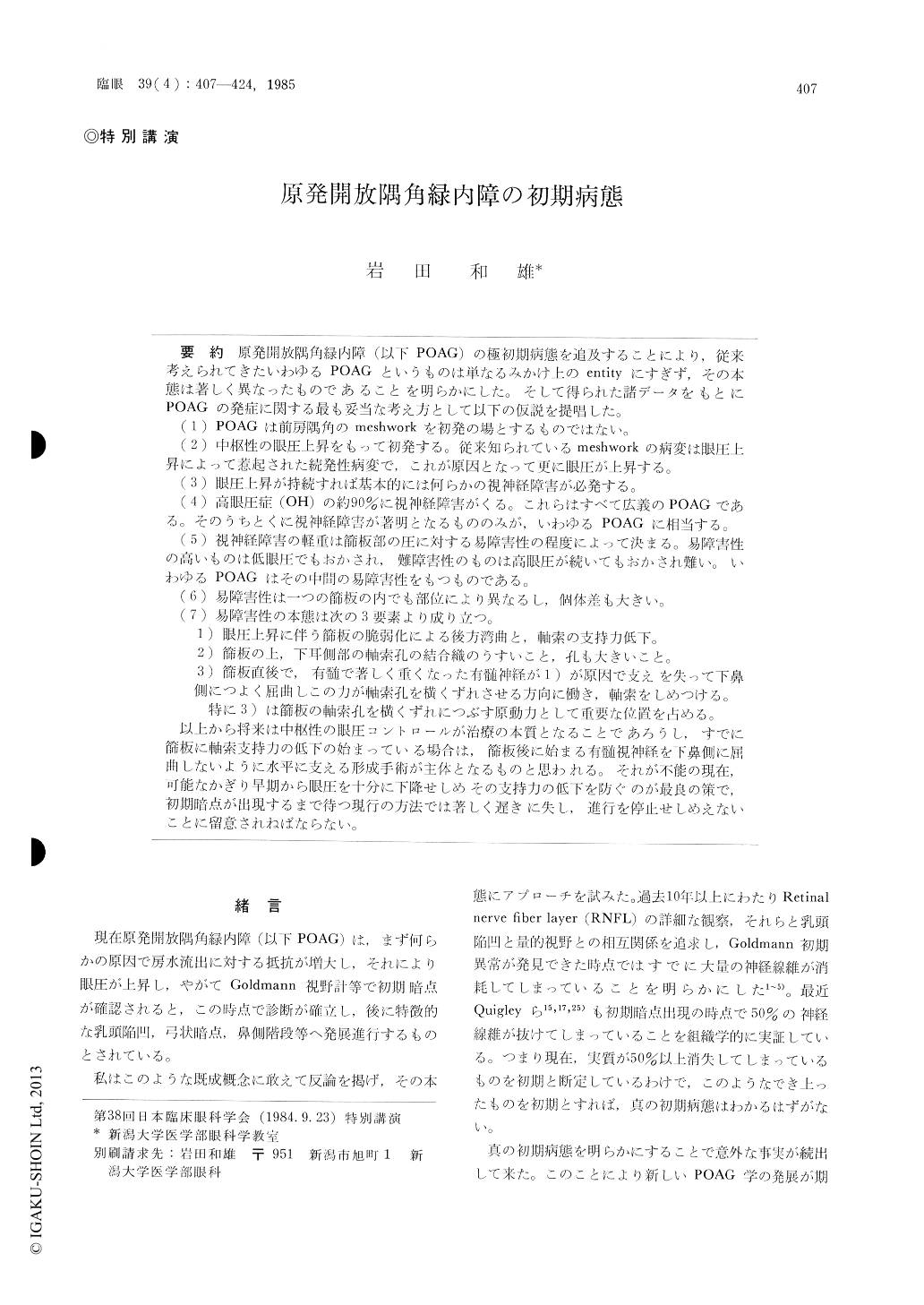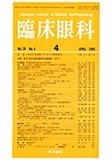Japanese
English
- 有料閲覧
- Abstract 文献概要
- 1ページ目 Look Inside
原発開放隅角緑内障(以下POAG)の極初期病態を追及することにより,従来考えられてきたいわゆるPOAGというものは単なるみかけ上のentityにすぎず,その本態は著しく異なったものであることを明らかにした.そして得られた諸データをもとにPOAGの発症に関する最も妥当な考え方として以下の仮説を提唱した.
(1) POAGは前房隅角のmeshworkを初発の場とするものではない.
(2)中枢性の眼圧上昇をもって初発する.従来知られているmeshworkの病変は眼圧上昇によって惹起された続発性病変で,これが原因となって更に眼圧が上昇する.
(3)眼圧上昇が持続すれば基本的には何らかの視神経障害が必発する.
(4)高眼圧症(OH)の約90%に視神経障害がくる.これらはすべて広義のPOAGである.そのうちとくに視神経障害が著明となるもののみが,いわゆるPOAGに相当する.
(5)視神経障害の軽重は篩板部の圧に対する易障害性の程度によって決まる.易障害性の高いものは低眼圧でもおかされ,難障害性のものは高眼圧が続いてもおかされ難い.いわゆるPOAGはその中間の易障害性をもつものである.
(6)易障害性は一つの篩板の内でも部位により異なるし,個体差も大きい.
(7)易障害性の本態は次の3要素より成り立つ.
1)眼圧上昇に伴う篩板の脆弱化による後方湾曲と,軸索の支持力低下.
2)篩板の上,下耳側部の軸索孔の結合織のうすいこと,孔も大きいこと.
3)篩板直後で,有髄で著しく重くなった有髄神経が1)が原因で支えを失って下鼻 側につよく屈曲しこの力が軸索孔を横くずれさせる方向に働き,軸索をしめつげる. 特に3)は飾板の軸索孔を横くずれにっぶす原動力として重要な位澱を占める. 以上から将来は中枢性の眼圧コントロールが治療の本質となることであろうし,すでに飾板に軸索支持力の低下の始まっている場合は,節板後に始まる有髄視神経を下鼻側に屈曲しないように水平に支える形成手術が主体となるものと思われる.それが不能の現在,可能なかぎり早期から眼圧を十分に下降せしめその支持力の低下を防ぐのが最良の策で,初期暗点が出現するまで待つ現行の方法では著しく遅きに失し,進行を停止せしめえないことに留意されねばならない.
Through application of stereophotography of the fundus using 35mm or 60×60mm color film, I could detect the earliest lesion in primary open-angle glaucoma (POAG) with small but progressive disc cupping and retinal nerve fiber layer (RNFL) ab-normality even in the absence of detectable visual field defects. The paracentral scotoma or the nasal step appeared 5 to 10 years after this stage. Hence, these visual field abnormalities were to be regarded not as the earliest but the more advanced sign of POAG.
A series of 18 cases with assymetrical POAG were evaluated. The advanced eye showed reduced fa-cility of outflow, while the fellow eye in the earli-est stage showed IOP below 20mmHg with normal facility of outbow, indicating the absence of damage in the endothelial meshwork in the chamber angle. These fellow eyes started to show abnormal values of IOP and facility of outflow. These fellow eyes were thus evidently different from simple hyper-secretion glaucoma with IOP elevation as the ini-tial sign. The rise in IOP might be due to a disorder in the IOP control center in the central nervous system. Lesions in the endothelial meshwork in the chamber angle should be considered to be secon-dary changes.
In spite of the generally accepted view that only 10% of eyes with ocular hypertension (OH) develop into POAG in 10 years, I detected glaucomatous RNFL thinning in 90% of 79 eyes with OH. These 90% of OH eyes thus seemed to be POAG in a wider sense. Conversely, the so-called POAG is to be re-garded as only a part of POAG in the wider sense, the former being characterized as a group with more vulnerable optic disc.
From our experimental glaucoma studies in cy-nomolgus monkey, the vulnerability of the optic disc was attributed to the peculiar wall structureof tube-like pores of lamina cribrosa, particularly larger pores with thinner connective tissue. An elevated IOP caused compression of glial tissue of the tube-like pores through which the nerve axons penetrate, resulting in side-bent destruction. As a new conclusive finding, we could demonstrate that the major force to bend the tube-like pores is at-tributed to the downward bending of the heavily medullated axons just behind the lamina cribrosa, due to loosening of the supporting connective tis-sue in the anterior portion of the lamina cribrosa.

Copyright © 1985, Igaku-Shoin Ltd. All rights reserved.


